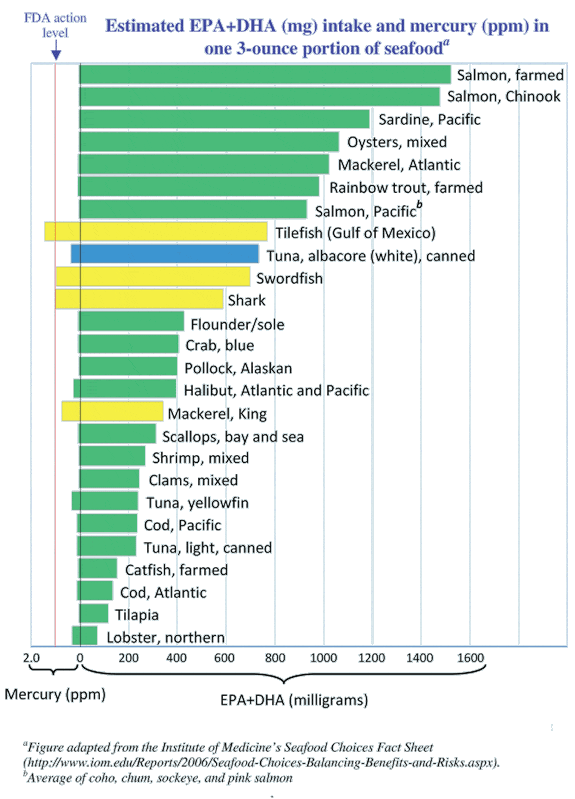Seafood was initially recognized as a healthy food choice because it is a low-fat source of high quality protein. Because high-fat diets were associated with increased risk for coronary heart disease (CHD) and some cancers, the National Research Council (NRC) recommended substituting fish for fatty meats and whole-milk dairy products as a way of reducing fat and cholesterol intake. Seafood is indeed a high-protein food that is lower in calories, total fat and saturated fat when compared to other protein-rich animal foods. Seafood also contains a number of vitamins (A, B-complex, and D) and minerals (selenium, iodine, iron and zinc) that have been linked to various health benefits. Studies have shown that eating seafood can decrease the risk of heart attack, stroke and hypertension.
U.S. Health organizations recommend consuming 250 mg of EPA+DHA per day, and suggest a diet containing 8 ounces of fish per week, especially species high in omega-3s, will provide a beneficial average daily intake. The American Heart Association recommends 1000 mg of EPA/DHA per day for patients with coronary heart disease. Pregnant woman and their children also benefit from omega-3s and 2010 Dietary Guidelines for Americans recommend at least 8 ounces and up to 12 ounces of seafood per week to get the healthy benefits of EPA and DHA. Fish with medium to high levels of omega-3 fatty acids include oily ocean fish, such as salmon, herring, mackerel and sardines.
Summary of Food Safety Issues
Despite the demonstrated positive health effects of seafood, there are also several potential hazards that have been found in seafood, including pathogens, marine toxins, environmental pollutants, and heavy metals. The greatest risk to human health is from pathogens and toxins in seafood; which can mostly be controlled through proper storage and handling. Recently many people have questions about the trace levels of contaminants such as mercury and PCBs (polychlorinated biphenyls) that have been found in fish.
Risk-Benefit Analysis
Recent risk-benefit studies have demonstrated that the benefits of seafood consumption greatly outweigh the risks. These studies have investigated the overall health effect from eating seafood, by considering low-level contaminants such as mercury and the positive health benefits nutrients including EPA and DHA. .
Researchers at the Harvard Center for Risk Analysis examined a variety of fish consumption scenarios and published their findings in a series of papers in the November 2005 issue of the American Journal of Preventative Medicine. Overall, they found that reducing seafood consumption would significantly reduce quality adjusted life-years for society as a whole, even when considering toxic compounds such as methylmercury. In other words, the risks of not eating fish were greater than any risks associated with eating fish. In order to maximize health benefits by eating seafood twice per week, American consumers will need to more than double their current seafood consumption levels.
Maximizing Benefits and Minimizing Risk
- U.S. health organizations recommend a daily EPA+DHA intake of 250 milligrams (mg) for most consumers and 1000 mg for people with cardiovascular disease. FAO/WHO experts recommend that DHA should account for at least 200 mg of the daily intake for pregnant or nursing women and daily EPA+DHA intake among children should be 100-250 mg.
- Only 1 in 5 Americans currently meet the recommendations set by the U.S. Food and Drug Administration, Dietary Guidelines Advisory Committee, and American Heart Association guidelines to eat fish twice per week
Risk-Benefit Table
The chart below is designed to summarize the major benefits and risks associated with mercury levels in common seafood products. It shows the average level of EPA+DHA and concentration of mercury in a 3-ounce serving of seafood. All seafood highlighted in green is well below the FDA action level of 1.0 part per million (ppm) for methylmercury (MeHg) in seafood, indicated by the red line on the chart. Albacore (white) tuna is highlighted in blue. It is a good source of EPA+DHA but has moderate levels of mercury. Sensitive groups (e.g. children 12 years and under, women who are or could become pregnant, and breastfeeding women) should eat 6 ounces of albacore tuna per week. The four seafood species highlighted in yellow are higher in mercury and should not be eaten by these sensitive groups. Sensitive groups should eat a variety of seafood twice per week to maximize health benefits, but they should choose options that are lower in mercury.

Seafood and Health Information for Healthcare Providers
This brochure is designed to summarize what is currently known about the nutritional benefits associated with seafood consumption as well as information on specific food safety risks. It also contains guidelines for consumers to help them include seafood in their diet in a way that will provide nutritional benefits and minimize potential risks.

